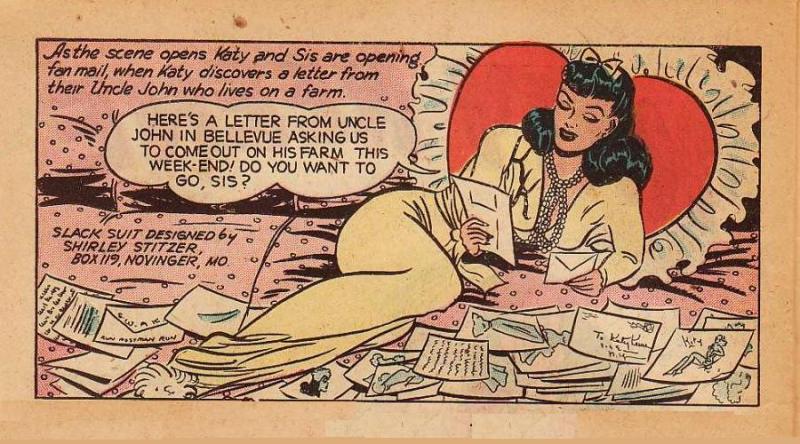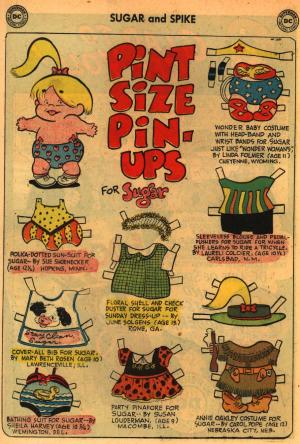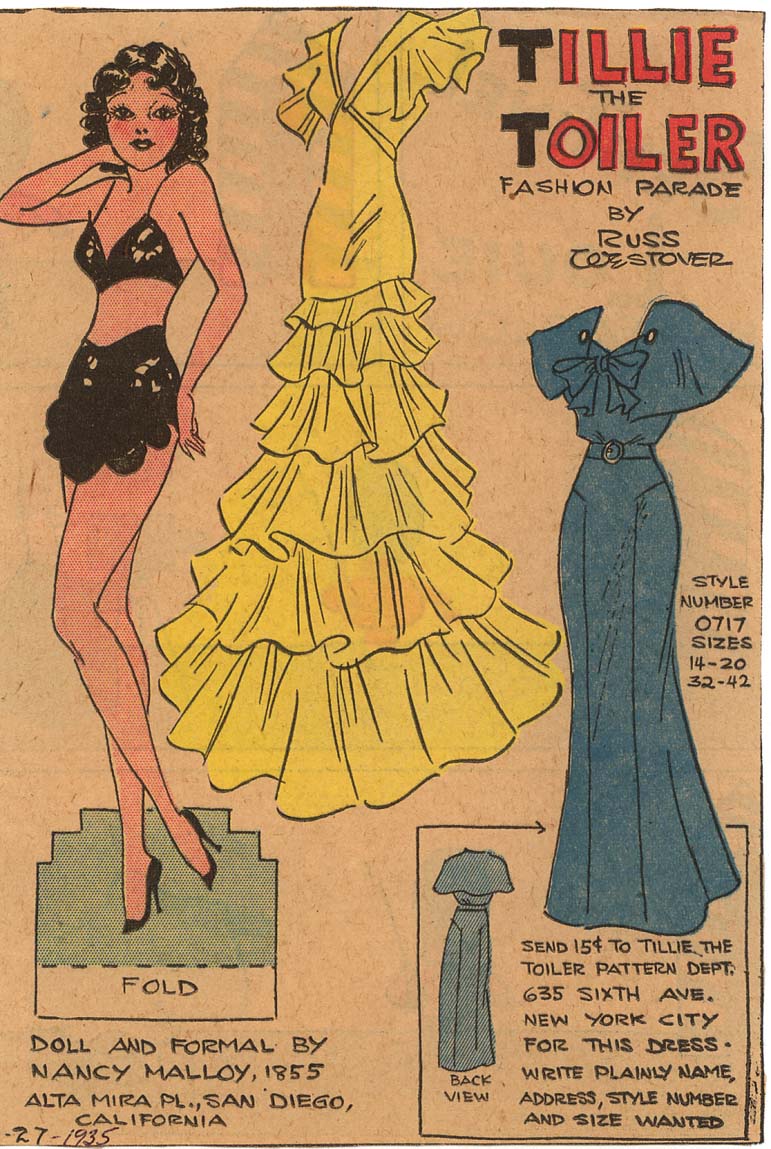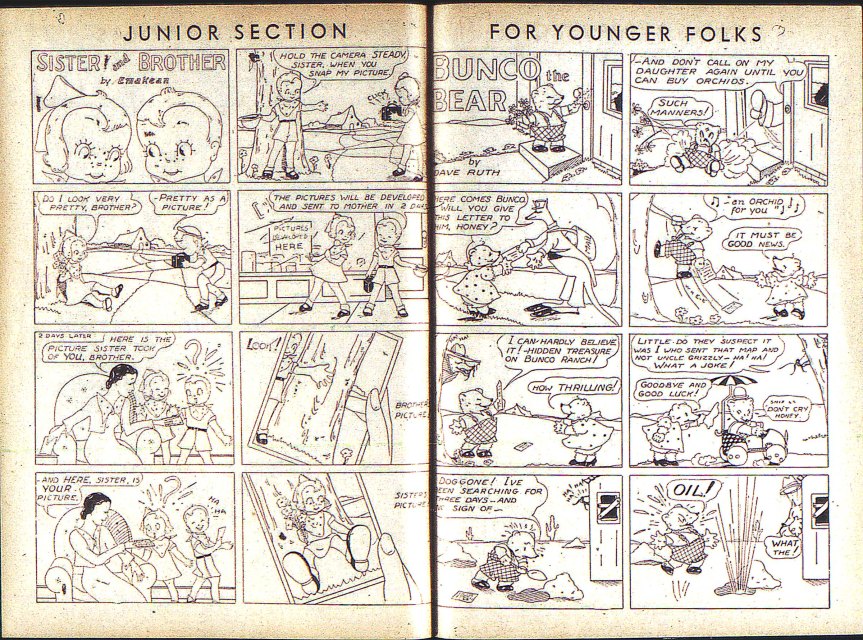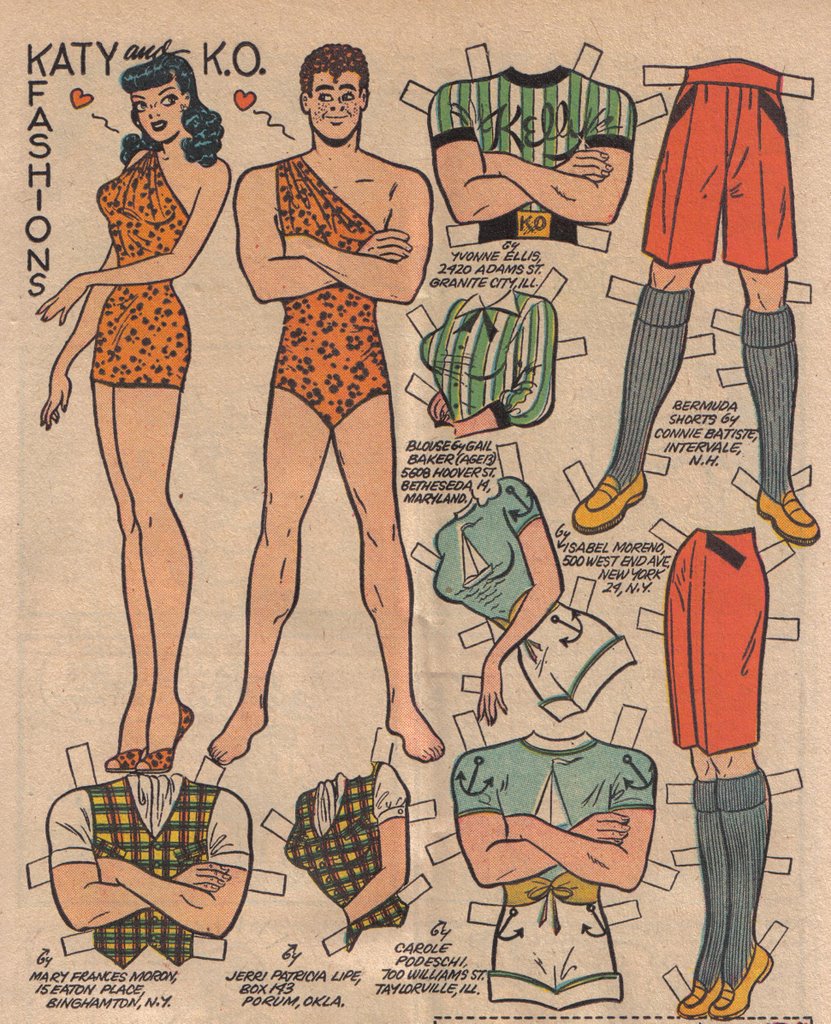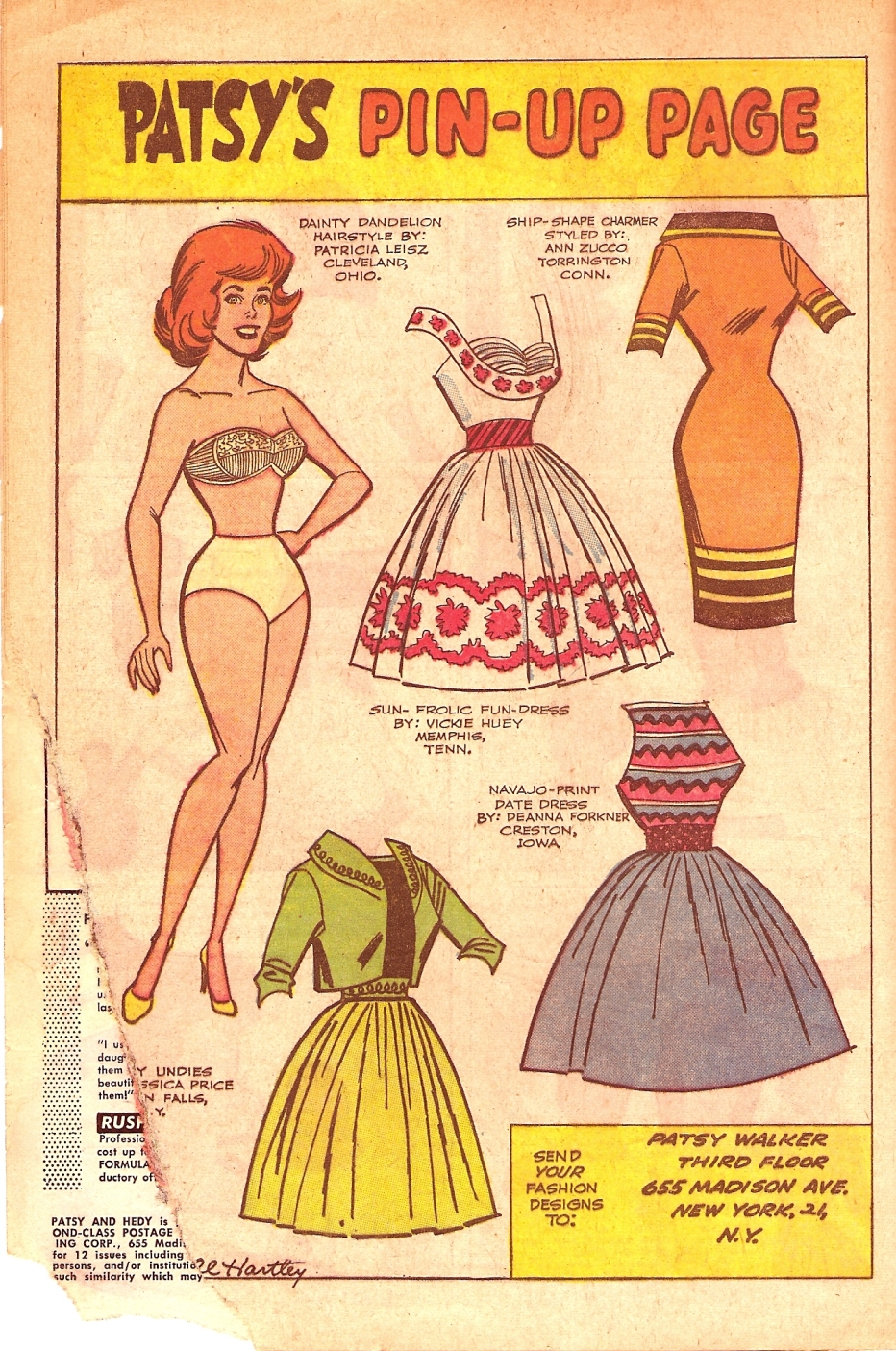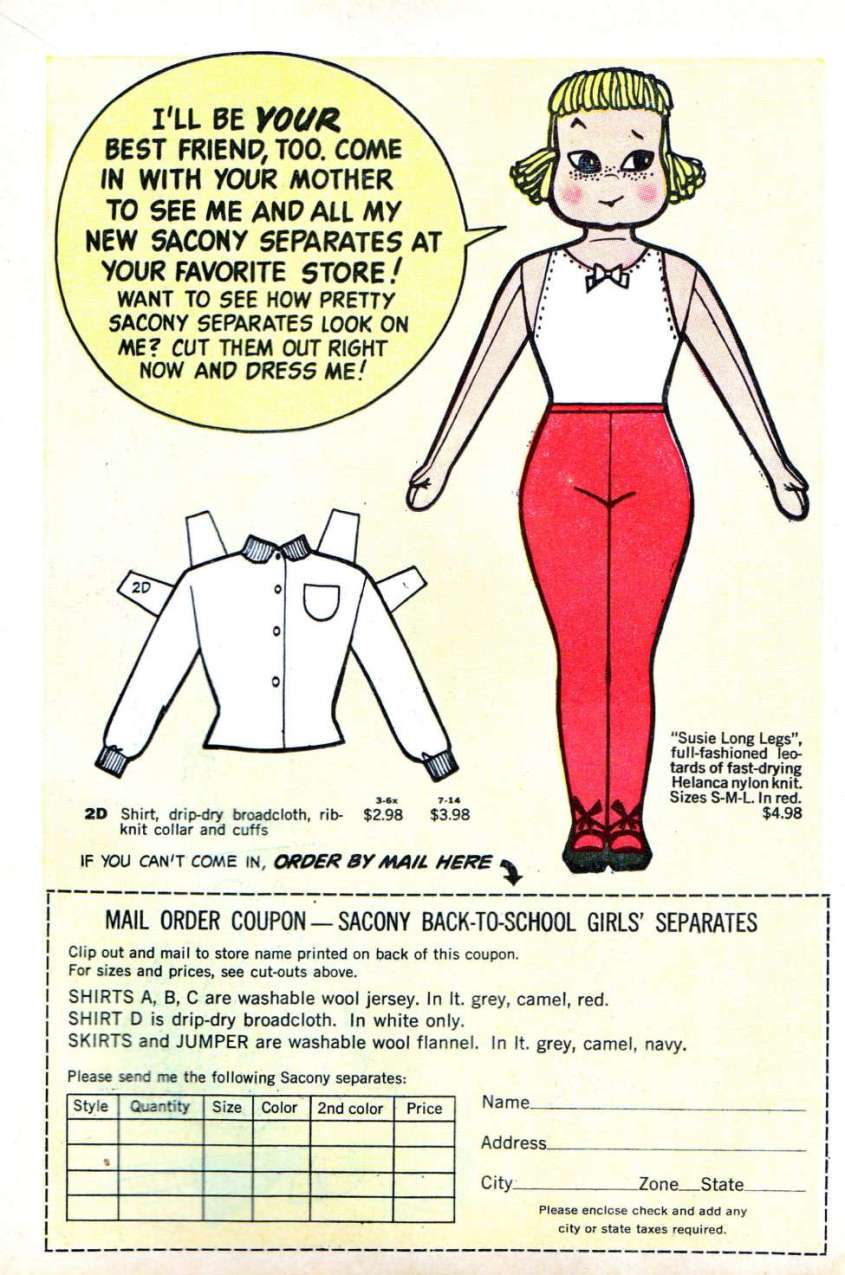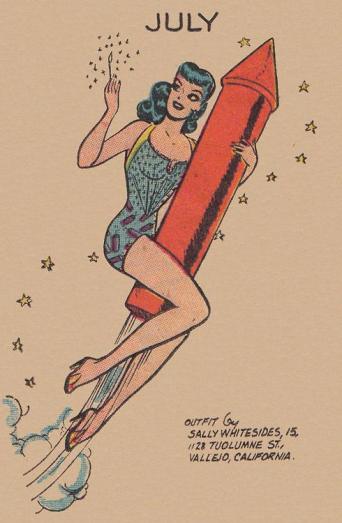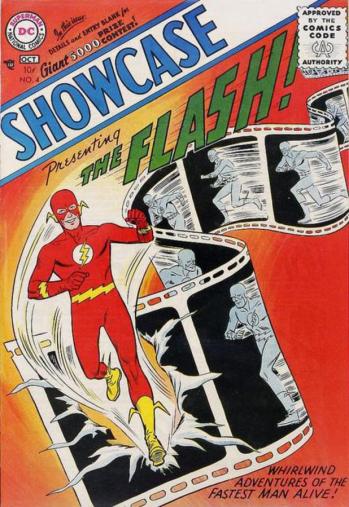by Jimmm Kelly
—————————————————————–
[For more paper doll fashions see also the extra page: Paper Doll Convention Hall]
cut ‘n’ paste
Growing up in a working class household, where we weren’t exactly showered with gifts (my mother likes to say that we were regarded as a charity case by the rest of the neighbourhood–maybe that’s where some of the funny books came from), we made do with whatever came to hand.
It wasn’t just the funnies that we cut up for paper dolls. Magazines and catalogues provided ready material, as well. I never heard a word of caution about using scissors. Whatever cardboard was hanging about (such as the cardboard from the package for my mother’s nylons–and my father used her old nylons for his tomatoes in the backyard–we were like Inuit hunters, every bit of our catch was put to use) we would paste the paper image on the cardboard (taking the occasional lick of the paste–which was sometimes homemade, too) then cut around the figure.
——-
pint size pin-ups
The most ready available funny book for this enterprise was the legendary SUGAR AND SPIKE.
From the time I was the age of Spike himself, these play toys were already extant–a fossilized record of whole issues that existed before I emerged from the primeval ooze–the funny books themselves having been traded or thrown onto the firepits of my forebears.
Not only did we have the ready-made Sugars and Spikes with the changes of dress from the comics–we also had some that my sisters had made on their own using the originals as a model.
Once I got lost in my own fantasy world of super-heroes–making up all kinds of possible characters–I learned to trace images from the funny books.
Sometimes I would cut out the actual figures, but I realized it was a lot better to trace over the images. Or simply slip some carbon paper under and then outline the image with a pencil or pen, so the image transfers to a clean piece of paper under the carbon. We had lots of carbon paper that my dad had brought home from work.
After I had traced an image of Superman or Batman onto blank paper and mounted that tracing onto cardboard, I could then modify the image and colour it.
Some of my new heroes could fly, so I made wings for them, which I tied with string to my paper dolls.
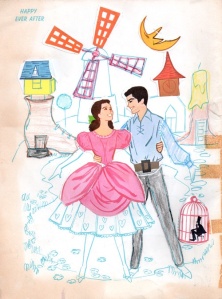
BABES IN TOYLAND STICKER FUN BOOK (Whitman ’61)
One of my sisters hadthis BABES IN TOYLAND STICKER FUN BOOK, which was like a colouring book but with stickers you pulled out and put on the pages to complete the drawings. This was based on the ’61 Disney movie starring Annette Funicello [based on the operetta of the same name]. Another BABES IN TOYLAND book had punch out paper doll figures.
It was true. And more than that, it was possible to spin any number of fantasies out of them. And I could make my own images, paper dolls and even my own funnies. So why should one continue to spend his allowance on new comics? It made no rational sense.
babes in toyland
There are numerous websites devoted to paper dolls–and you should look for them. I will only give the briefest history here.
It’s a fact that paper dolls are as old as paper itself. Paper dolls became popular in Europe in the 18th century and in France they were called pantins.
Then, in the United States, starting in the early 1800s, McLoughlin Brothers rose as the largest producer of paper dolls.
The company was sold to Milton Bradley in 1920, when the fashion for paper dolls in the U.S was on the upswing.
———————————————————————-
Consuelo Vanderbilt’s troubled marriage, circa 1895, even provided the subject for paper dolls.
———————————————————————-
i’d rather have a paper doll

1919 magazine illustration of actress Norma Talmadge and some of her film costumes in paper doll form (Photo credit: Wikipedia)
The song PAPER DOLL was written in 1915 by Johnny S. Black. At this time, paper doll collections, usually focusing on celebrities and movie stars of the day, appeared in books and magazines published by Lowe, Whitman or others.
The newspapers would also feature paper doll pages.
The comic strip, TILLIE THE TOILER, by Russ Westover, began in the ’20s and by the early ’30s there was the Tillie the Toiler Fashion Parade— paper doll pages, with suggestions from readers–and patterns you could send away for.
These designs and patterns remind me of the patterns my mother and sisters would buy. They would spread the paper patterns out on the living room floor and with pins in her mouth, my mother would cut the cloth pinned to the patterns. Half of my sisters’ clothes were made this way. My mother sewed all the bride’s maid dresses for my oldest sister’s wedding. Tillie the Toiler was one of my mother’s favourite funnies when she was a young lady.
A small feature buried among all the adventure stories in the first issue of National Allied’s NEW COMICS (December ’35) is the Junior Section for Younger Folks featuring the one page Sister and Brother by Ema Kean–followed by the one page Bunco Bear by Dave Ruth.
On the following page, there’s a paper doll for young ladies to colour and cut-out, featuring the Travel Twins (apparently in Holland) by Emma McKean.
None of these features would appear in the issues of NEW COMICS to follow. Emma McKean did return in issues 3 (February ’36) and 4 (March-April ’36) to do a two pager called Sara Lou Sunshine, but no paper dolls. McKean would also work for Dell comics in the early ’40s.
PAPER DOLL by the Mills Brothers shot to the top of the charts in ’43 with their recording of Johnny S. Black’s song from 1915.
The popularity of the Mills Brothers record might have had something to do with the popularity of paper dolls in wartime, in spite of paper drives and shortages. This was the golden age for paper dolls, just as it was the golden age for funny books.
——-
when paper fashion was keene
In talking about the Batman family (see issue 3), I said that Batwoman was likely a reinvention of Catwoman. But I also believe the name of her alter ego of Kathy Kane might owe something to another Kate–Katy Keene! [In Bob Kane’s mind since he had invented the name of Kane for himself, he likely felt he had a pre-existing right.]
Katy Keene was introduced to the funnies over ten years before Kathy Kane–first in MLJ’s WILBUR COMICS No. 5 (Summer ’45). And then in several other funny books, before getting her own title in 1949. She was a pin-up girl of fashion and it was routine for her to wear outfits suggested by her readers. There would be credits in every panel where Katy was shown in new attire. As a result, there were several costume changes per story. In addition, feature pages had pin-ups of Katy in reader-suggested ensembles, and paper doll fashions for her to wear.
While I’m sure this pleased her female readers–who seem to be the ones sending in suggestions–it must’ve pleased her male readers even more. Not only was Katy shown in various states of dress, but various states of undress, as well.
——-
a doll that other fellas cannot steal
Other funny books got into the pin-up fashion and paper doll cut-out act.
In addition to Katy Keene, Archie Comics had BETTY AND VERONICA and SUZIE; Marvel had PATSY AND HEDY and MILLIE THE MODEL; Charlton had MY LITTLE MARGIE; DC had A DATE WITH JUDY; Tower had TIPPY TEEN, and so on.
It was a great enterprise. Before comic book fandom took off, there were already kids and adults sending in their own ideas for the funnies. A truly interactive experience. Even if you hadn’t sent in the ideas, you could always cut out the dolls and play your own games with them. And what a showcase for Good Girl art! Result: satisfaction for all!
With Barbie and other dolls like her, little girls were lured away from the paper doll fashions. Now they needed to acquire all the advertised accessories for Midge or Tressie. A much more expensive proposition for the parents.
For the kids whose families couldn’t afford such indulgences, paper remained the most affordable medium for play–until the comic book collectors’ market, with its promise of gold at the end of a four colour rainbow, told kids to put away their scissors.
————————————–
PAPER DOLL
by Johnny S. Black, 1915
–lyrics as recorded by The Mills Brothers in 1942
I’m gonna buy a Paper Doll that I can call my own
A doll that other fellows cannot steal
And then the flirty, flirty guys with their flirty, flirty eyes
Will have to flirt with dollies that are real
When I come home at night she will be waiting
She’ll be the truest doll in all this world
I’d rather have a Paper Doll to call my own
Than have a fickle-minded real live girl
I guess I had a million dolls or more
I guess I’ve played the doll game o’er and o’er
I just quarrelled with Sue, that’s why I’m blue
She’s gone away and left me just like all dolls do
I’ll tell you boys, it’s tough to be alone
And it’s tough to love a doll that’s not your own
I’m through with all of them
I’ll never ball again
Say boy, whatcha gonna do?
I’m gonna buy a Paper Doll that I can call my own
A doll that other fellows cannot steal
And then the flirty, flirty guys with their flirty, flirty eyes
Will have to flirt with dollies that are real
When I come home at night she will be waiting
She’ll be the truest doll in all this world
I’d rather have a Paper Doll to call my own
Than have a fickle-minded real live girl
[For more fun things to do with paper, check out: 40 Uses for a Dead Funny Book.]
————————————–
————————————–
NEXT TIME . . . something completely different:
Meister Eder Forever!
————————————–
CA-NA-DA by Bobby Gimby
***
. . . for the first week in July . . . Motor City madness has touched the countryside . . .
July 1, 1867, noon–New Brunswick, Nova Scotia, and the Canadas (Upper and Lower) are proclaimed the Dominion of Canada. Lower Canada is henceforth named Quebec and Upper Canada is named Ontario. John A. Macdonald serves as first prime minister. It is a mostly sunny day throughout the Dominion, as towns large and small celebrate the new nation. In Toronto, children wave Union Jacks and an ox is roasted before St. Lawrence Hall–the meat served to the poor. On Parliament Hill, in Ottawa, soldiers neglect to take the ramrods out of their rifles, so that when they fire a salute, the rods fly over Sparks Street. In Quebec City the roar of the cannon is heard over the Plains of Abraham. In Halifax, while some celebrate, others despair and burn Charles Tupper in effigy, along with a live rat, on the waterfront. In her diary, a little girl of Hamilton records the words of her father to her:
This is the First of July, in the year eighteen hundred and sixty seven . . . always remember this day, and this night. You are a very lucky little girl, to be a child in Canada, today.
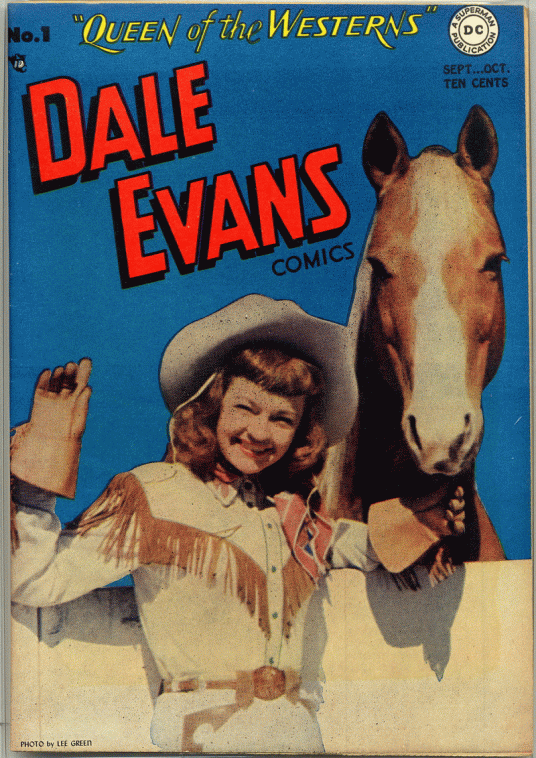 Roy Rogers married Dale Evans in December 31 ’47–it was his third marriage and Dale’s fourth. The marriage contract didn’t extend to the funny books–maybe the publishers thought it wouldn’t last. Roy had got his own title from Dell which went on sale in November ’47, a month before his wedding nuptials. Less than a year later the Queen of the Westerns gets her own comic from DC. The first issue of DALE EVANS COMICS (November-December ’48) goes on sale around July 2 ’48–also in her title, Sierra Smith the cowboy detective, featuring art by Alex Toth–with a photo cover.
Roy Rogers married Dale Evans in December 31 ’47–it was his third marriage and Dale’s fourth. The marriage contract didn’t extend to the funny books–maybe the publishers thought it wouldn’t last. Roy had got his own title from Dell which went on sale in November ’47, a month before his wedding nuptials. Less than a year later the Queen of the Westerns gets her own comic from DC. The first issue of DALE EVANS COMICS (November-December ’48) goes on sale around July 2 ’48–also in her title, Sierra Smith the cowboy detective, featuring art by Alex Toth–with a photo cover.
Availble on July 2 ’68, SUPERBOY 150 (September ’68) has a chilling tale of smalltown horror–who were the strange men who came to visit and would not leave?
DETECTIVE COMICS 186 (August ’52) introduces the Flying Bat-Cave–on sale July 3 ’52.
This is the startling tale of the Flash–a man who was so fast that he not only outraced his shadow–but he also broke through the sound barrier–on foot! . . .
SHOWCASE No. 4 (September-October ’56) presents the revival of the Human Thunderbolt in the form of police scientist Barry Allen–which will have a major impact on the funny book trade from then on! Written by Bob Kanigher and John Broome. Illustrated by Carmine Infantino and Joe Kubert. From the desk of editor Julius Schwartz. Hurry to your news dealer on July 5 ’56.
Hope you had a great Bicentennial celebration all you flag-waving funsters. Now it’s time to raid your local newsstand and grab the milestone 250th (October ’76) issue of ARCHIE GIANT SERIES MAGAZINE (what began as ARCHIE’S CHRISTMAS STOCKING in 1954, when your mother was a bobby-sockser)–it’s a Betty and Veronica Spectacular! On sale July 5 ’76.
On July 6 ’42, Anne Frank’s family go into hiding in the attic above her father’s business. You can read the tragic story in picture form, from Sid Jacobson and Ernie Colon, in their ANNE FRANK published by Pan MacMillan (2010)–and, of course, there’s THE DIARY OF ANNE FRANK, written by Anne herself, published by various. Disturbing but necessary reading.
In MORE FUN COMICS 46 (August ’39), Mounty Sgt. O’Malley of the Red Coat Patrol fights crime in the Canadian Rockies with his young partner Black Hawk. But you don’t have to go all the way to the Canadian Rockies–it’s at your local newsstand on July 7 ’39.
top
***
All on sale dates might be approximate, as provided by Mike’s Amazing World of Comics (The Newsstand) and by other sources.
All characters, logos, and images are owned and © 2013 by current copyright holders. They are used here for educational and review purposes.


